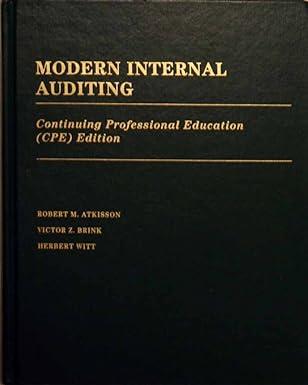Question
1. The balanced scorecard gets its name from a. an attempt to provide short-run financial results with long-run financial strategies. b. an attempt to balance
1. The balanced scorecard gets its name from
a. an attempt to provide short-run financial results with long-run financial strategies.
b. an attempt to balance product quality and cost reduction.
c. an attempt to match a companys own capabilities with the opportunities in the marketplace to accomplish an overall objective.
d. an attempt to balance financial and nonfinancial performance measures to evaluate both short-run and long-run performance in a single report.
2. Many companies have tried to downsize in an attempt to eliminate
a. inefficiencies and waste associated with nonvalue-added costs.
b. their unused capacity.
c. costs associated with both direct and indirect labor.
d. costs through using information technology.
3.Which of the following statements is true about productivity measures?
a. A major disadvantage of total factor productivity is that it measures the combined productivity of all inputs to produce output.
b. Partial productivity and total factor productivity measures work best together because the strengths of one are the weaknesses of the other.
c. Total factor productivity is calculated by dividing the costs of all inputs used by the quantity of output produced.
d. The higher the inputs for a given quantity of outputs or the lower the outputs for a given quantity of inputs, the higher the level of productivity.
4. Which of the factors that managers must consider in deciding the allocation of resources across customers might provide misleading signals about dropping a current customer?
a. Potential for customer growth
b. Likelihood of customer retention
c. Long-run customer profitability
d. Ability to learn from customer
5. Information about price discounting can be useful in analyzing revenues of customers if
a. sales people are properly trained in sales forecasting.
b. records in the information system are kept of reductions in selling price below list price.
c. a strictly enforced company policy is in place regarding volume-based price discounts.
d. sales people are on an incentive plan that is based on revenues.
6. The use of a dual-rate cost-allocation method recognizes
a. the improvements in technology allowing for use of multiple cost pools.
b. the need to use both budgeted and actual cost rates when allocating.
c. the need to use both budgeted and actual usage of quantities when allocating.
d. the behavior aspect of costs.
7. If a cost is incurred for more than one user, that cost is considered a(n)
a. homogeneous cost.
b. common cost.
c. stand-alone cost.
d. incremental cost
Step by Step Solution
There are 3 Steps involved in it
Step: 1

Get Instant Access to Expert-Tailored Solutions
See step-by-step solutions with expert insights and AI powered tools for academic success
Step: 2

Step: 3

Ace Your Homework with AI
Get the answers you need in no time with our AI-driven, step-by-step assistance
Get Started


